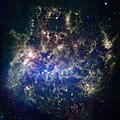Tập tin:Magellanic Cloud.jpg

Kích thước hình xem trước: 600×600 điểm ảnh. Độ phân giải khác: 240×240 điểm ảnh | 480×480 điểm ảnh | 768×768 điểm ảnh | 1.024×1.024 điểm ảnh | 2.048×2.048 điểm ảnh | 13.250×13.250 điểm ảnh.
Tập tin gốc (13.250×13.250 điểm ảnh, kích thước tập tin: 58,1 MB, kiểu MIME: image/jpeg)
Lịch sử tập tin
Nhấn vào ngày/giờ để xem nội dung tập tin tại thời điểm đó.
| Ngày/giờ | Hình xem trước | Kích cỡ | Thành viên | Miêu tả | |
|---|---|---|---|---|---|
| hiện tại | 10:49, ngày 28 tháng 12 năm 2011 |  | 13.250×13.250 (58,1 MB) | Prof. Professorson | Highest resolution, from http://www.spitzer.caltech.edu/images/1670-ssc2006-17b1-Large-Magellanic-Cloud-in-the-Infrared (http://www.spitzer.caltech.edu/uploaded_files/images/0006/2139/ssc2006-17b1.jpg). |
| 10:20, ngày 28 tháng 12 năm 2011 |  | 6.000×6.000 (7,32 MB) | Bulwersator | full image (from source) | |
| 10:14, ngày 28 tháng 12 năm 2011 |  | 516×387 (63 kB) | Bulwersator | Transferred from en.wikipedia: see original upload log above |
Trang sử dụng tập tin
Có 1 trang tại Wikipedia tiếng Việt có liên kết đến tập tin (không hiển thị trang ở các dự án khác):
Sử dụng tập tin toàn cục
Những wiki sau đang sử dụng tập tin này:
- Trang sử dụng tại en.wikipedia.org
- Trang sử dụng tại id.wikipedia.org
- Trang sử dụng tại it.wikibooks.org
- Trang sử dụng tại simple.wikipedia.org

